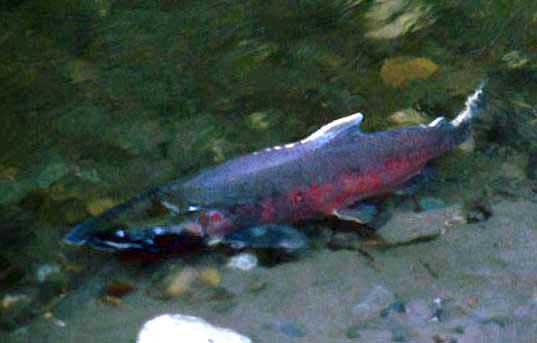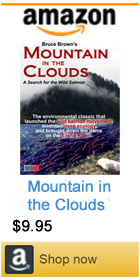‘Gone Fish Watching’ by Bruce Brown
A new sport — fish watching — is born…
“Gone Fish Watching” by Bruce Brown originally appeared in the August 1986 issue of Audubon Magazine.

IT WAS A DUSTY TREK from Hoodoo Pass down to Boiling Lake and up over Horsehead Pass into the Eagle Lakes Basin that August afternoon. Packhorses, trail bikes, and the thousands of sheep that are driven through the area had pulverized the soil to the consistency of fine face powder.
For much of the exposed climb to 7,600-foot Horsehead Pass in Washington’s North Cascades, the wind kept us walking in our own dust, even though we were the only ones on the trail at the time. We paused long enough on the summit to study a forest fire burning out of control several thousand feet below and dozens of miles to the east, and then hurried on down toward the Eagle Lakes chain.
Because a Forest Service trail crew had warned us that Eagle Creek was the only local source of drinking water free of the parasite Giardia, my companions and I pulled out our poly bottles when we arrived at the inconspicuous little creek that connects the lower two Eagle Lakes. Heading upstream forty or fifty feet to get away from the trail and its contaminants, I bent down at the edge of a small pond at the base of a plashing waterfall, and was neatly as startled as the trout with whom I found myself face to fare at a distance of perhaps a foot.
Retiring discreetly to a vantage point behind a log, I realized that this little pond, which measured perhaps ten feet by twenty feet and was no more than calf-deep, contained a dozen trout. Although small, ranging from four to an honest ten inches in length, they were handsome fish and unusually marked: a warm golden color with a faint flush of red on the gill covers, and as heavily spotted as an African leopard. These black spots, which occurred both above and below the lateral line, seemed to form a larger snakeskin-like pattern of chevrons that pulsated along their flanks as they swam.
A waterfall at the head of the pool and boulders at ins tail prevented the fish from fleeing to another part of the stream. Within a few minutes they had calmed down and returned to their seemingly casual circling in search of food. Most followed the bits of sunken drift that tumbled over the falls, but I also saw one jump straight up out of the water alter an insect and bend double in midair like a jackknife, whose size it closely approximated.
The Eagle Lakes are a great fishing Mecca, but fishermen who hike and ride past by the hundreds every summer show no interest in these fish, which I guessed were some kind of a rainbow-cutthroat hybrid. Fishing for them would be like fishing in your bathtub, and even if you caught the whole mess of them there wouldn’t be enough to make a decent meal for one person. There was no challenge here, and so the sportsmen sped on to bigger water and the ever-more-distant lakes. For us, however, this tiny pool pro- vided a fascinating microcosm, a place where the ways of fish and water could be studied with clarity from a reclining position. I remember thinking at the time, too, that these fish showed how traditional fishing differs from the sport that has been quietly rising in its shadow for the better part of a century, namely fish-watching.

ACTUALLY, FISH CAN BE SEEN in many more situations than people suspect, from deep in the wilderness to the heart of some cities, from both coasts to the many rivers and lakes of the American Midwest. I myself have observed salmon, trout, that, and other choice cold-water game fish everywhere from the remote wilds of Alaska to the dock off the back of one of Seattle’s fanciest lakeside watering holes, where the gunmetal-blue silhouettes of sockeye salmon slide through the reflections of the mercury vapor lights.
It is obviously impossible to see fish where there are none, but a knowledgeable observer can often see and identify more fish than an equally experienced fisherman can catch in the same place during the same period of time. And unlike the scuba-diving expeditions of saltwater fish-watchers like Jacques Cousteau, the sport of freshwater fish-watchers requires no exceptional bravery, foreign travel, expensive gear, or macho skills. Freshwater fish-watching is something you can do when you just want an excuse to go sit by a stream or lake for an hour. Because the equipment needs ate minimal, the freshwater fish-watcher is both ready for the unexpected encounter and free from the frustrations of broken leaders and snarled reels.
Certain aspects of fish behavior can only be investigated completely by fishing in its various and storied forms, but fishing does nor (and in fact can- not) reveal the complete piscine mystery. Fishing is an artificial test of response under stress which, if successful, removes the fish entirely from its natural surroundings and behavior. Despite the great sense of rapport and appreciative understanding that characterizes the best fishermen, fishing per se is blind to the undisturbed world of fish. The instant the hook is set, all normal affairs on both ends of the line are abandoned.
Fish-watching, by contrast, is almost exclusively concerned with the natural creature, darting and dashing, lolling in the depths of a pool or hiding under a root bail. Its quarry is the one that got away; its aim, to keep it that way.
THE OBVIOUS ANALOG of fish-watching is birdwatching. Each is devoted to the appreciation of often beautiful creatures that ate capable of movement in a medium that is closed to humans, and each is the outgrowth of subsistence, commercial, and sport killing of the same.
Just as John James Audubon was an accomplished shooter of birds for table and study, many pioneering fish- watchers have been fishermen who came to linger longer and longer in the presence of their supposed prey. Fly-fishermen in particular must spend time studying fish to be effective, and in certain parts of England “fishing ethics require the fisherman to see his fish before he casts for it,” according to Nick Lyons, the noted fisherman, author, and publisher of fishing books. To observe salmon and trout from their own perspective, one fly-fisherman, the late Roderick Haig-Brown, even snorkeled in the same Vancouver Island rivers he fished. Most fish-watchers, however, ate content with watching from the shore, or as far from it as hip boots will take them.
Fish-watching shares certain fundamental principles with birdwatching (for example, it is generally most effective in either case to wait for the creatures to come to you, rather than to pursue them); but, because of the special visual qualities of water, there ate also a number of differences. For the sake of observation and concealment, one must realize that the fish sees the world outside the stream as a circle of light shimmering overhead, the objects closest to the fish drawn into distorted relief against the sky at the center. Originally described and photographed just before world War I by pioneer English fish-watcher Francis watcher, this circle of light resembles the aptly named “fish-eye” effect produced with an extremely wide-angle lens in photography.
For the fish-watcher, there are other limits to vision that must be considered. Surface opacity is almost always a problem to one degree or another. It can be reduced by putting the sun at your back, by wearing polarized sunglasses of the sort used by many fishermen, and by attempting, wherever possible to get at least ten feet above the water, as on bridges or climbable trees along the shore. One dedicated fish-watcher, Pennsylvania State University researcher Robert Bachman, has even gone to the trouble of erecting aluminum scaffolding along the bank of Pennsylvania’s Spruce Creek to create a permanent elevated fish-watching blind in a place where none presented itself naturally.
Itinerant fish-watchers generally find the natural terrain to be both obstacle and ally, often frustrating their efforts but also occasionally presenting exceptional vistas. Last summer a friend and I found such a fish-watching vista in the cliffs above a mountain lake in Olympic National Park. Although we had come to do some climbing around Mount Deception, we spent the better part of the day watching more than a thousand red-finned brook trout cruising the waters of Royal Lake, and taking dozens of photographs which did not turn out.
Another method of fish-watching used on lakes and saltwater is the so-called glass-bottomed bucket, which can be anything from commercial products like the Aquascope to homemade combinations of pipe and glass to a simple swimming mask laid on the water. Here the idea is to cut the reflective interference by providing the human viewer with a vantage point just under the surface of the water. Despite the limitations of a relatively narrow field of vision, glass-bottomed buckets can open up the underwater world better than anything short of a swim when conditions are right.
As an outdoor sport, fish-watching may not be as popular as bird watching or fishing, but it has more adherents than many people might think. In Yellowstone National Park in 1978, for instance, 130,000 people used Fishing Bridge as a vantage point to watch trout in the Yellowstone River, according to Paul Schullery, a writer and a former Yellowstone naturalist and ranger. “In August of that year,” says Schullery, “more people watched fish from the bridge than fished in the whole park.”
Thousands of spectators line the high banks of British Columbia’s Adams River to watch the large tuns of sockeye salmon that flood that tributary of the Fraser River every four years. People also congregate at spots like northern Vermont’s Willoughby River to watch rainbow trout leap at impassable falls, according to Tom Rosenbauer, editor of Orvis News.

IF YOU SPEND enough time watching fish — and an afternoon in the right place can be enough time — you become aware that there is considerable variety and drama in fish behavior. Far front being cold and alien, as many people think of them, fish can be heatedly emotional and express themselves through a variety of physical displays.
In spawning season, for instance, Pacific salmon characteristically put on a prolonged dance of prowess that illustrates their mastery over moving water. They chase, parry, circle, and dash, and become progressively consumed by procreative frenzy as they near the death that claims virtually all of them after they spawn. Some even have the ability to change their elaborate mating colors almost instantaneously to reflect a change in their position in the nest hierarchy. In a matter of seconds, the fish that looked at first glance like a plain female chum salmon reveals itself to be a boldly hued male.
Eventually, the fish-watcher may get the feeling that he himself is being watched. The feeling first came over me one November afternoon I spent on Breckenridge Creek, a stream near my home in western Washington. The weather had just turned cold and clear after a week of rain, and I suspected the wild run of coho salmon might be in. I’d waded barely a half mile from the bridge when I came around a bend to the sight of two coho males thrashing their way up out of the water in desperate combat fifteen yards ahead of me. Each was about two feet long and had a rich flash of burgundy on its flanks. The slender females nearby occasionally chased each other when one dug too close to the nest of another, but most of the action came from the brightly colored bucks, who drove at each other repeatedly, attempting to rake their opponents with their wicked canines.
The dominant male of the bunch was a six-pounder with red-hot-iron sides, a blue-black head, white moustache-like markings on his upper lip, and a white stripe down the crest of his back, which was out of the water often as he defended his turf. From the bleached, knife-edge look of his back, I guessed he was nearing the end and would probably spawn that night.
I tried to creep closer, but when I came to within a dozen yards he suddenly rushed straight up the twisting rope of fast water and across the stream to a point directly even with me. Less than five feet separated us as he rode the current as easily as a hawk on the wind, and he was plainly scrutinizing me with his unblinking eye.
I expected the terrified explosion of water that usually comes when a salmon sees or smells a man, but this fish did not seem to be afraid. He hung before me for several seconds, as if we were connected by something much finer even than 8X tippet, and then slowly fell off on the current, letting it catty him back toward his mate, tail first.
After waiting long enough to see that he did not sound the alarm to the other fish, I headed the other way, pondering the possibility that I had been seen by a salmon and recognized as a friend.
“Gone Fish Watching” originally appeared in the August 1986 issue of Audubon. © Copyright 1986 Bruce Brown




